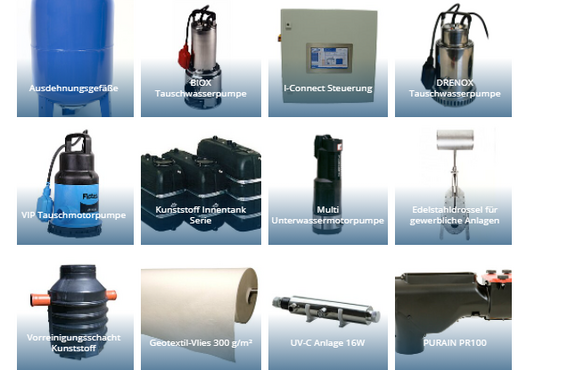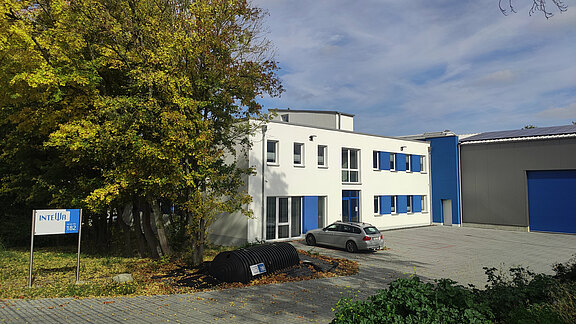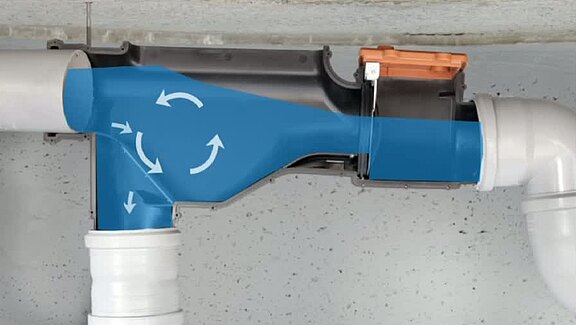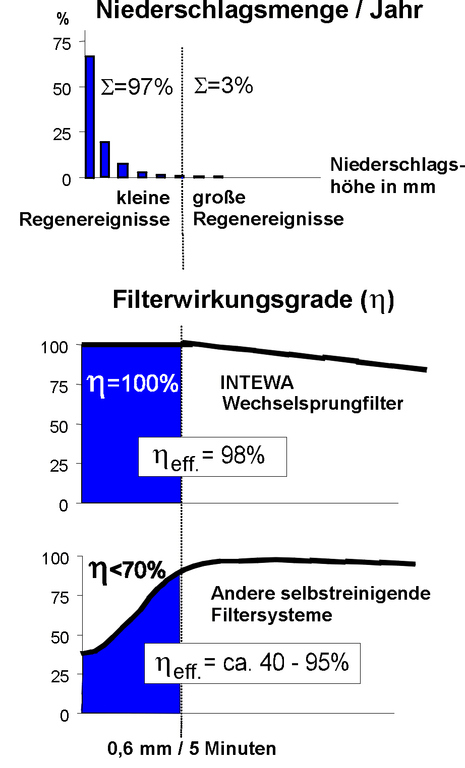In recent years, however, the voices have become louder, which complain of significantly lower efficiencies and a greater maintenance effort than specified by the manufacturers. Even more problematic is the fact that in practice the poor function of these filters is usually not even noticed, since the rainwater systems today automatically switch to drinking water when there is a shortage of rainwater. If however over 50% of the valuable rain water, which is to be observed in practice frequently, simply disappears in the overflow, the alarm bells should ring actually with all operators and offerers of such plants. Each year besides in such a way also many million m³ of valuable drinking water are used too much.
The ideal rainwater filter should have the following characteristics:
- an effective efficiency of >90
- almost maintenance-free operation
- a minimal height offset
The actual precipitation behavior
Over a period of 2 years, the actual precipitation behavior was examined more closely by the Research Center for Water Management and Environment at the University of Siegen. Surprisingly, there is still a great need for information among experts:
| Precipitation event mm/5min | % Share of precipitation events in total precipitation 1993-1997 |
| 0,1 | 66,72 |
| 0,2 | 18,99 |
| 0,3 | 7,52 |
| 0,4 | 2,96 |
| 0,5 | 1,19 |
| 0,6 | 0,75 |
| 0,7 | 0,47 |
| 0,8 | 0,29 |
Thus, more than 90% of the annual precipitation occurs during particularly small rainfall events down to only 0.3 mm/5min, as the following table illustrates.
However, many filter systems on the market do not take this precipitation behavior into account at all, since they have large losses precisely in these very small rainfall events. Often their screens are already so dirty after a few rain events that just these small volume flows simply flow into the overflow. Some systems examined in the hydraulic engineering laboratory of the Siegen University of Applied Sciences even showed effective efficiencies of less than 50%. The poor results are also confirmed by many end users in practice, who are always wondering why their rainwater storage tanks collect so little water.
Does the German standard for rainwater filters help consumers?
The German standard for rainwater filters will not change anything in the future. This is because various efficiencies at volume flows are to be examined as criteria for the suitability of a filter system. In practice, these efficiencies are completely irrelevant because, although they bring a short-term strong volume flow, in total they only account for a few % of the total rainwater yield. However, the most important thing that should interest the customer is the total rainwater volume that he can collect over the year with his filter system. (effective efficiency) However, the standard is silent about this amount. The customer can therefore buy a filter that has a good efficiency according to the standard, but still collects far too little water.
The solution principle "change jump":
Yet it can work so simply. The PURAIN rainwater filter filters 100% of the smaller rainfall that provides the maximum amount of water through its initial collecting function in a sink. This provides an effective overall efficiency of 98%. Large precipitation events, which occur approximately 4 to 10 times per year and contribute only about 3% of the water yield, are used for the self-cleaning function. A flow vortex, the so-called alternating jump, flushes the filter clean during these heavy precipitation events. A stainless steel slotted screen with a mesh size of 800 μm ensures an ideal cleaning effect. The PURAIN filter deliberately dispenses with the so-called initial throw, which is recommended by some suppliers. Even the initial precipitation is collected 100%, because it contributes significantly to the overall effective efficiency. Dirt and water can be raised again by the alternating jump almost to the same level of the inflow. The height offset of the outflowing water is thus minimal.
The function stages
The next figure shows the two functional stages of the filter.
1. For volume flows up to about 0.6 l/s, the filter functions as a collecting system. 100% of the rainwater passes through the sieve into the cistern.
2. at volume flows from about 0.6 l/s, the alternating jump is formed. A rotating flow carries the dirt that has accumulated in the sink into the overflow.
Backwater flap, small animal protection and overflow skimmer
In the standard version PURAIN PR 100 are a skimmer overflow and a backwater flap (at the same time small animal protection) directly integrated. If the overflow is connected to a rainwater sewer, DIN 1989-1 requires that a simple backwater flap be installed in the future to protect rainwater harvesting systems. The skimmer effect provides an additional improvement of the water quality of the cistern at each overflow event.
For roof areas from 60 to 6,000 m²
INTEWA offers the PURAIN filters for roof areas between 60 and about 6,000 m². For even larger roof areas, several filters can be coupled.
Practical experience
The PURAIN rainwater filter has now been successfully used in over 20,000 rainwater systems. The filter system has made a name for itself in use by private homeowners as well as in the commercial sector. Numerous customers have even exchanged their old filter systems for the new one, allowing direct comparison.
Summary
The most important thing that should interest the customer is the total amount of rainwater that he can collect over the year with his filter system. This can only be expressed by the so-called effective efficiency.
Using the principle of the "alternating jump", INTEWA GmbH has succeeded in filtering 100% of the important small rain events and thus achieving an effective efficiency of 98%. The larger rain events flush the filter free of accumulated dirt with a flow vortex a few times a year and additionally ensure an almost maintenance-free operation of the filter system. After extensive practical experience, the filter system was able to impressively demonstrate its performance and thus make a valuable contribution to the further development of stormwater technology.
The complete test results of the Water Management and Environment Research Center of the University of Siegen can be downloaded from www.intewa.de. There you will also find an illustrative video on the function of the alternating jump.
(6680 characters, incl. spaces)
Author: Oliver Ringelstein





